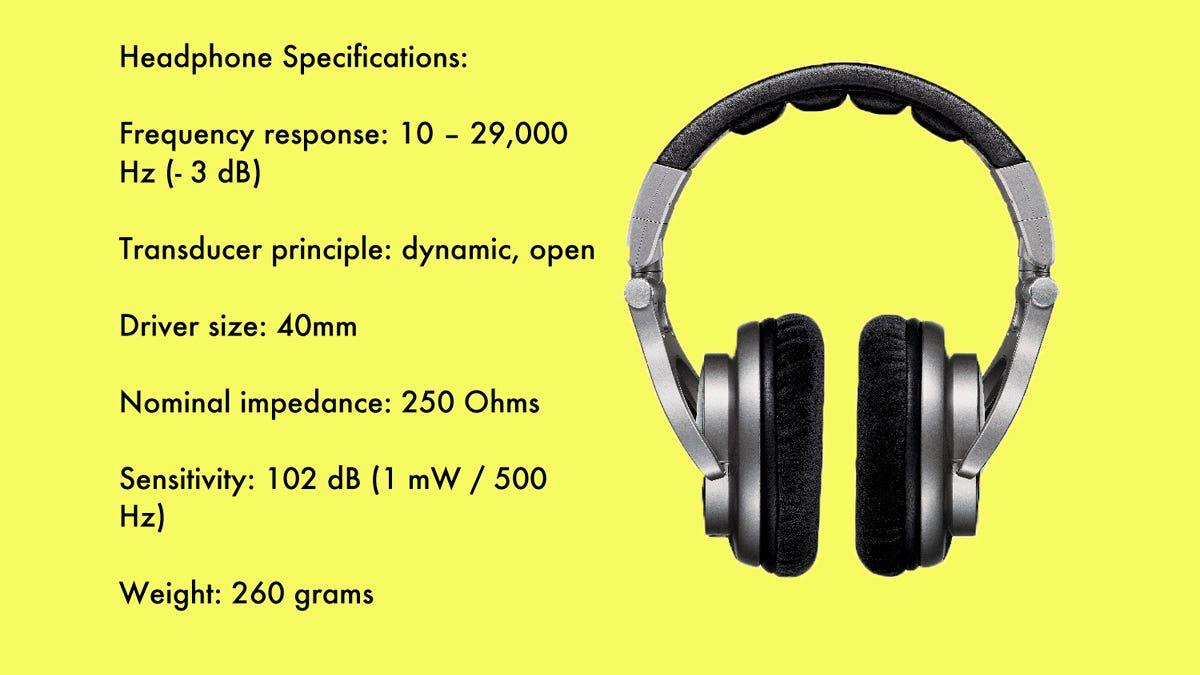 Why You Can Trust CNET
Why You Can Trust CNET Here's what you need to know about headphone specifications
What do headphone specs really mean? The Audiophiliac asks Sennheiser's Axel Grell to explain.

I've listened to and reviewed hundreds of headphones, and here's what I've learned: they all sound different. Examining their specifications -- frequency response, impedance, sensitivity, driver size, etc. -- rarely yields useful information. For me the only spec that (sometimes) matters is the easiest one to understand -- weight -- because weight and long-term comfort are related.
To learn more about headphone specs I chatted with Sennheiser's Axel Grell, who over the last 22 years developed 23 headphones for the company. Grell's deep knowledge shed light on what the numbers really mean.
We started with frequency response, and Grell said, "It has theoretical value, something you can measure, but only if the spec includes a -3 or -10 dB tolerance, otherwise the spec doesn't mean anything." Few brands provide frequency response specs that way, but if the manufacturer lists the spec like this, 15 - 28,000Hz (-3 dB), that's more useful than 15 - 28,000Hz, without the - dB part. The first number in a frequency response spec refers to the deepest bass frequency the headphone can reproduce, the lower the number the better; and the second number refers to the highest frequency the headphone is capable of, and the higher the better.
If a headphone spec includes very high frequencies above 23,000Hz, that's a good sign, and the headphone might sound clearer than a headphone with a 18,000Hz spec. Granted, few people over the age of 20 hear these very high frequencies, but Grell points out that headphones with extended high frequencies also sound great in the treble range people of all ages can hear.
As for deep bass, low frequency response with closed-back, full-size, and in-ear headphones, the best bass is only achievable when the earpieces have an airtight seal. Unfortunately, when head shape, eyeglasses or hair compromise the seal, bass suffers. The less perfect the seal, the greater the bass losses. Even so, well-designed closed headphones tend to have deeper bass than open headphones. Then again, since open-back headphones don't require a perfect seal to deliver full bass response, open-back headphones' bass sounds more consistent from one listener to the next.
Sennheiser's Axel Grell
Grell explained that with in-ear headphones the length, diameter and curvatures of the user's ear canals affect the listener's perceived frequency response. If your canals are close to the ones the engineers were designing for, you will hear the sound they intended. The more your canals diverge from the target, the less accurate the headphone's frequency response will be from 2,000Hz and up. In other words, the sound heard by people with ears that match the target will be very different than people with ears that don't. The good news is most people's ears are reasonably close to the design target, but there's no way to know if your ears are close to average.
Grell claims custom-molded in-ear headphones don't offer any advantage on that score (Sennheiser doesn't make custom in-ear headphones). He thinks for most people a properly fitting universal fit in-ear is more likely to sound better than a custom-molded headphone, but if a universal in-ear headphone's ear tips aren't providing a tight seal the sound won't match the designers' target frequency response curve. So if your in-ear headphones aren't doing a good job sealing out noise, you're not hearing their true sound quality. Experiment with the tips that came with the headphone, but if they don't seal all that well, buy aftermarket tips.
What about headphone impedance? Are low-impedance headphones -- under 32 ohms -- better than higher impedance designs? A lot depends on whether the headphone will be used at home with an AC-powered receiver/headphone amplifier or a battery-powered portable music player. Home amps are more powerful than portable devices, and AC-powered amps produce more bass and tend to sound better with higher impedance headphones, like many Sennheiser and Beyerdynamic models. With smartphones and portable music players, low-impedance headphones of 32 ohms or less are recommended. At home impedance is less of an issue, but Grell recommends higher-impedance models.
Next we covered sensitivity, a more sensitive headphone will play louder than a less sensitive one at the same volume setting on your smartphone or headphone amp. Unfortunately, manufacturers aren't consistent in the ways they define sensitivity. Grell has a problem with specs that rely on mW (milliwatt) numbers, for example, 100 dB/1 mW; amplifiers aren't delivering mWs, they deliver volts. Again, since headphone makers aren't consistent with the way they create specifications, consumers can't compare one headphone spec with another to learn which headphone will play loud enough to suit their needs.
What about driver size? Do larger drivers sound better, play louder or make more bass than smaller drivers? Grell had a two word answer, "Definitely not." Larger drivers do a poor job reproducing high frequencies. Grell says the maximum driver size should be around 42mm (for full-size headphones); with larger drivers the surface of the diaphragm physically changes shape at high frequencies and produces irregular frequency response. Larger drivers can generate cleaner bass, but less accurate high frequencies.
With in-ear headphones Grell feels 6.5mm drivers easily generate very deep bass, and excellent high-frequency sound. Larger drivers offer no advantage over smaller drivers. The overall design of the driver and headphone are much more important than driver size, but those differences don't show up in specs. The differences in design are only apparent when you listen.
So as it stands, headphone specs are mostly useless, but Grell is discussing with other headphone brands' engineers new industry standards that would go a long way to help consumers make informed choices. That's going to take time; for now the best way to judge a headphone's sound is to listen to it. Grell concluded with this advice: "Trust your ears."

